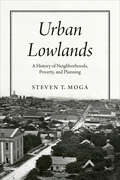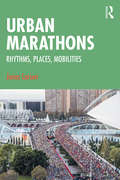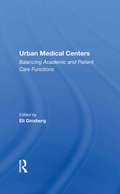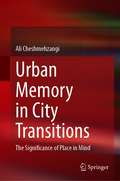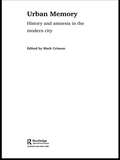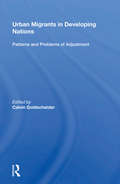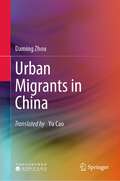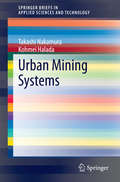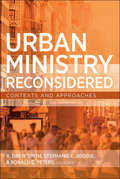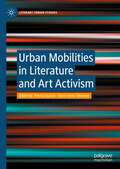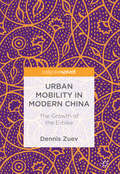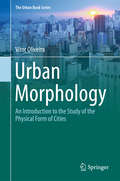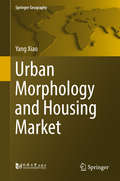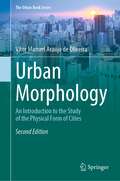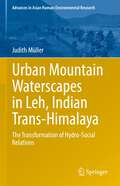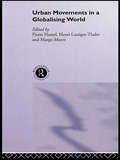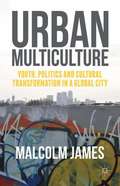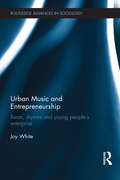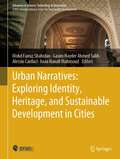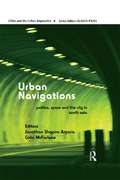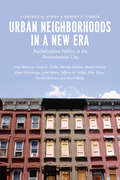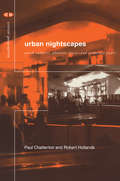- Table View
- List View
Urban Lowlands: A History of Neighborhoods, Poverty, and Planning (Historical Studies of Urban America)
by Steven T. MogaIn Urban Lowlands, Steven T. Moga looks closely at the Harlem Flats in New York City, Black Bottom in Nashville, Swede Hollow in Saint Paul, and the Flats in Los Angeles, to interrogate the connections between a city’s actual landscape and the poverty and social problems that are often concentrated at its literal lowest points. Taking an interdisciplinary perspective on the history of US urban development from the nineteenth to the mid-twentieth century, Moga reveals patterns of inequitable land use, economic dispossession, and social discrimination against immigrants and minorities. In attending to the landscapes of neighborhoods typically considered slums, Moga shows how physical and policy-driven containment has shaped the lives of the urban poor, while wealth and access to resources have been historically concentrated in elevated areas—truly “the heights.” Moga’s innovative framework expands our understanding of how planning and economic segregation alike have molded the American city.
Urban Lowlands: A History of Neighborhoods, Poverty, and Planning (Historical Studies of Urban America)
by Steven T. MogaIn Urban Lowlands, Steven T. Moga looks closely at the Harlem Flats in New York City, Black Bottom in Nashville, Swede Hollow in Saint Paul, and the Flats in Los Angeles, to interrogate the connections between a city’s actual landscape and the poverty and social problems that are often concentrated at its literal lowest points. Taking an interdisciplinary perspective on the history of US urban development from the nineteenth to the mid-twentieth century, Moga reveals patterns of inequitable land use, economic dispossession, and social discrimination against immigrants and minorities. In attending to the landscapes of neighborhoods typically considered slums, Moga shows how physical and policy-driven containment has shaped the lives of the urban poor, while wealth and access to resources have been historically concentrated in elevated areas—truly “the heights.” Moga’s innovative framework expands our understanding of how planning and economic segregation alike have molded the American city.
Urban Marathons: Rhythms, Places, Mobilities
by Jonas LarsenThis original social science text approaches marathon running as an everyday practice and a designed event, to draw upon and contribute to the literature on practice theory, urban events, rhythmanalysis and mobility. It bridges sport studies and discussions within sociology and geography about practice, movement and the city. Inspired by theoretical debates about embodied and multi-sensuous mobilities, social and material practices, and urban rhythms, this book explores the characteristics of marathon running as a bodily practice on the one hand and, on the other, marathon training grounds and events as unique places. This account takes marathon running seriously, using sociological and geographical theory to understand the practice in and of itself. Based on original empirical research and accessible to readers, taking them to training sessions in Copenhagen and to marathons in Tokyo, Kyoto, Berlin, Frankfurt, Valencia and Copenhagen, it draws out the globalised, codified and generic nature of marathon practices and design, yet also brings out the significant local differences. The book examines in ethnographic detail how marathon practices and places are produced by various materialities, cultural scripts, experts, runners and spectators, and practiced in embodied, multi-sensuous and ‘emplaced’ ways by ordinary runners. It develops a sociological practice approach to marathon running and geographical understanding of marathon places and rhythms. It demonstrates that marathon running is of broad interest because it calls for and allows lively and expressive ways of conducting and writing research and understanding the becoming of bodies, the intertwining of biological and mechanical rhythms, and the eventful potential of streets. It will appeal to postgraduate students and scholars in sport studies, geography and sociology interested in running, active mobility and ethnography, as well as tourism and urban events. The book will also appeal to general readers with an interest in marathon running.
Urban Masses and Moral Order in America, 1820-1920
by Paul BoyerFor over a century, dark visions of moral collapse and social disintegration in American cities spurred an anxious middle class to search for ways to restore order. In this important book, Paul Boyer explores the links between the urban reforms of the Progressive era and the long efforts of prior generations to tame the cities. He integrates the ideologies of urban crusades with an examination of the careers and the mentalities of a group of vigorous activists, including Lyman Beecher; the pioneers of the tract societies and Sunday schools; Charles Loring Brace of the Children's Aid Society; Josephine Shaw Lowell of the Charity Organization movement; the father of American playgrounds, Joseph Lee; and the eloquent city planner Daniel Hudson Burnham. Boyer describes the early attempts of Jacksonian evangelicals to recreate in the city the social equivalent of the morally homogeneous village; he also discusses later strategies that tried to exert a moral influence on urban immigrant families by voluntarist effort, including, for instance, the Charity Organizations' "friendly visitors." By the 1890s there had developed two sharply divergent trends in thinking about urban planning and social control: the bleak assessment that led to coercive strategies and the hopeful evaluation that emphasized the importance of environmental betterment as a means of urban moral control.
Urban Medical Centers: Balancing Academic And Patient Care Functions
by Eli GinzbergThis volume reports the different ways in which various urban academic health centers are seeking to reposition themselves in order to protect and advance their primary missions of education, biomedical research, and sophisticated patient care.
Urban Memory in City Transitions: The Significance of Place in Mind
by Ali CheshmehzangiAs a continuation of ‘Identity of Cities and City of Identities’, this book covers the arguments around the memory-experience-cognition nexus concerning palimpsests and urban places. As cities experience transitional phases of growth, development, decline, and decay, the author urges considering the notion of urban memory in place-making strategies and design decision-making processes. These explorations would add value to primary fields of architecture, architectural history, cognitive science, human geography, and urbanism. Divided into eight chapters, this book puts together a comprehensive knowledge of urban memory in city transitions. By studying urban memory, the author delves into conceptions of mental mapping, knowledge of environments, cognition of places, and the perceptual dimension of urbanism. Undoubtedly, urban memory plays a significant part in the future movements of humanistic urbanism. Given the significances of scale, pace, and mode of city transitions globally, we should remember who are the ultimate users of those living environments. Therefore, in this book, the author debates two contradictions of ‘memory of place vs. place of memory’, and ‘significance of place vs. place of significance’. Each of these is believed to be a paradox of its own, indicating places are significant through the systematic networks of cities, memories are meaningful through the neural information processing, and place memories are the essence of urban identities.The book's ultimate goal is to demonstrate the effectiveness of the space-time frame of place in making memorable places. Through the comprehensive explorations of many global examples, we can evaluate the significance of place in mind more carefully. This is narrated based on the recognition of nostalgia in cities, socio-temporal qualities in places, and the network of processes in our minds. In return, the aim is to provide new knowledge to make memorable cities, enhance social experiences, and capture and value the significance of place in mind.
Urban Memory: History and Amnesia in the Modern City
by Mark CrinsonNine previously unpublished essays form an interdisciplinary assessment of urban memory in the modern city, analysing this burgeoning area of interest from the perspectives of sociology, architectural and art history, psychoanalysis, culture and critical theory. Featuring a wealth of illustrations, images, maps and specially commissioned artwork, this work applies a critical and creative approach to existing theories of urban memory, and examines how these ideas are actualised in the forms of the built environment in the modernist and post-industrial city. A particular area of focus is post-industrial Manchester, but the book also includes studies of current-day Singapore, New York after 9/11, modern museums in industrial gallery spaces, the writings of Paul Auster and W.G. Sebald, memorials built in concrete, and contemporary art.
Urban Migrants In Developing Nations: Patterns And Problems Of Adjustment
by Calvin GoldscheiderWhat are the effects of migration and the change to city life on migrants and their families in developing countries? How is the quality of life influenced by the influx of migrants into a region? This book addresses these and related questions by focusing on four case studies in Korea (Seoul), Indonesia (Surabaya), Colombia (Bogota), and Iran (Teh
Urban Migrants in China
by Daming ZhouThis book focuses on the background, migration, and settlement of new migrants in China. It also examines the status of their social networks, the role of urban society, social security, and future planning. Based on semi-structured interviews, the book analyzes these aspects of new urban migrants and argues that:- Intellectual migrants, with their strong educational background, are willing to engage in urbanization and have clear entry strategies.- Labor migrants find it is challenging for labor migrants to receive the same welfare as citizens and they are subject to significant segregation in urban societies due to existing policies and market economy conditions.- Operational migrants have stronger settlement and family-oriented tendencies compared to labor migrants.
Urban Mining Systems
by Takashi Nakamura Kohmei HaladaThis book focuses on the fundamental concept of and current endeavors in "urban mining" among those who are interested in both metal resources and ecology. Systems for recycling and reusing precious metals and rare-earth minerals contained in used and discarded electronics are introduced in this book. The target audience is not academic researchers in the resource management and ecology fields but, rather, citizens who are concerned about our future environment and want to do something for the future.
Urban Ministry Reconsidered: Contexts And Considerations
by R. Drew Smith Stephanie C. Boddie Ronald E. PetersUrban Mobilities in Literature and Art Activism (Literary Urban Studies)
by Patricia García Anna-Leena ToivanenUrban Mobilities in Literature and Art Activism explores the entwinement of mobility and immobility in urban spaces by focusing on their representation in literary narratives but also in visual and performing arts. Across a range of geographical contexts, this volume builds on the new mobilities paradigm developed by literary scholars, sociologists and human geographers. The different chapters employ a cohesive framework that is sensitive to the intersecting dimensions of power and discrimination that shape urban kinetic features. The contributions are divided into three sections, each of which places the focus on a different aspect of urban mobility: Itinerant Subjects, Modes of Transport and Places of Transit, and Urban Liminalities.Chapter 7, "Alienation, Abjection and the Mobile Postcolonial City: Public Transport in Ousmane Sembène’s “Niiwam” and Yvonne Vera’s Without a Name" is available open access under a Creative Commons Attribution 4.0 International License via link.springer.com.
Urban Mobility in Modern China: The Growth Of The E-bike
by Dennis ZuevThis book is an empirically rich case-study of what is currently the most popular alternative-fuel vehicle in the history of motorization – the electric two-wheeler (e-bike). The book provides sociological insights into e-bike mobility in China and discusses politics, social practices and larger issues of mobility transition in urban China. Taking an accessible approach to the subject, the book identifies the main sociospatial conflicts regarding the use of e-bikes and discusses why electric two-wheeler mobility is important for the future of urban China and urban transportation globally. This book will be an invaluable read for urban geographers and transportation researchers, but also for academics and general readers interested in Chinese Studies, specifically in the area of urban mobility in China.
Urban Morphology
by Vítor OliveiraThis is a book about cities or, more precisely, about the physical form of cities. It starts presenting the main elements of urban form - streets, urban blocks, plots and buildings - structuring our cities and the fundamental actors and processes of transformation shaping these elements. It then applies this analytical framework to describe the evolution of cities over history as well as to explain the functioning of contemporary cities. After the initial focus on the 'object' (cities) the book describes how different researchers and different schools of thought have been dealing with this object since the emergence of Urban Morphology, as the science of urban form, in the turning to the twentieth century. Finally, the book tries to identify what are the most important (and specific) contributions that Urban Morphology has to offer to contemporary cities, societies and economies.
Urban Morphology and Housing Market
by Yang XiaoThis book is devoted to fill the 'urban economics niche' and conceptualize a framework for valuing the urban configuration via local housing market. Advanced network analysis techniques are employed to capture the centrality features hindered in street layout. The author explores the several effects of urban morphology via housing market over two distinct contexts: UK and China. This work will appeal to a wide readership from scholars and practitioner to policy makers within the fields of real estate analysis, urban and regional studies, urban planning, urban design and economic geography.
Urban Morphology: An Introduction to the Study of the Physical Form of Cities (The Urban Book Series)
by Vítor Manuel Araújo de Oliveira'This is a textbook about cities or, more precisely, about the physical form of cities. It provides an overview of the main elements of urban form—streets, street blocks, plots and buildings—structuring our cities and the fundamental agents and processes of transformation shaping these elements. It applies this analytical framework to describe the evolution of cities over history as well as to explain the functioning of contemporary cities. After the initial focus on the 'object' (cities), the book introduces how different schools of thought have been dealing with this object since the emergence of Urban Morphology, as the science of urban form, in the turning to the twentieth century. Finally, the book identifies the main contributions of urban morphology to cities, societies and economies. This second edition of the book offers updated and more accurate knowledge on several morphological issues, presents expanded contents, and it has a more explicit didactic nature, including a set of exercises in the end of each chapter, that will help teachers and students (in architecture, geography, planning, history, sociology and urban studies) in acquiring and consolidating their urban morphological knowledge.
Urban Mountain Waterscapes in Leh, Indian Trans-Himalaya: The Transformation of Hydro-Social Relations (Advances in Asian Human-Environmental Research)
by Judith MüllerThe city of Leh is located in the high mountain desert of Ladakh in the Indian Himalayas and access to water has always been limited there. In recent years, the town has experienced high rates of urbanisation on the one hand, and tourist numbers have increased exponentially on the other, which has implications for the water supply of the people living there. Through several years of on-site research, challenges on various levels were documented and current governance approaches were analysed. This research forms the basis for future approaches to sustainable development.
Urban Movements in a Globalising World
by Pierre Hamel Margit Mayer Henri Lustiger-ThalerThis collection deals with the transformation of urban movements in these new social, economic and political environments.
Urban Multiculture: Youth, Politics and Cultural Transformation in a Global City
by Malcolm JamesThis book explores the transformation of youth and urban culture in neoliberal Britain. Focusing on the reconfiguration of urban culture in relation to race, marginalization and youth politics, James examines the shifting formations of memory, territory, cultural performance and politics.
Urban Multiculture: Youth, Politics and Cultural Transformation in a Global City
by Malcolm JamesThis book explores the transformation of youth and urban culture in neoliberal Britain. Focusing on the reconfiguration of urban culture in relation to race, marginalization and youth politics, James examines the shifting formations of memory, territory, cultural performance and politics.
Urban Music and Entrepreneurship: Beats, Rhymes and Young People's Enterprise (Routledge Advances in Sociology)
by Joy WhiteYouth unemployment in the UK remains around the one million mark, with many young people from impoverished backgrounds becoming and remaining NEET (Not in Education, Employment, or Training). However, the NEET categorisation covertly disguises and obscures the significance of the diverse range of activities, achievements and accomplishments of those who operate in the informal creative economy. With grime music and its related enterprise a key component of the urban music economy, this book employs the inherent contradictions and questions that emerge from an exploration of the grime music scene to build a complex reading of the socio-economic significance of urban music. Incorporating insightful dialogue with the participants in this economy, White challenges the prevailing wisdom on marginalised young people, whilst also confronting the assumption that the inertia and localisation of the grime culture results from its close links to NEET "members" and the informal sector. Offering an ethnographic and timely critique of the NEET classification, this compelling book would be suitable for undergraduate and post-graduate students interested in urban studies, business, work and labour, education and employment, ethnography, music, and cultural studies.
Urban Narratives: Exploring Identity, Heritage, and Sustainable Development in Cities (Advances in Science, Technology & Innovation)
by Gasim Hayder Ahmed Salih Mohd Fairuz Shahidan Alessio Cardaci Israa Hanafi MahmoudThis book engages readers in an enlightening exploration of cities' identities, sustainability, and urban development. Delving into the intricate interplay between art, architecture, and the urban landscape, it offers a compelling analysis of the factors that shape cities and their distinct personalities. The volume uncovers captivating stories of cities as they navigate the delicate balance between heritage conservation and modernity. It highlights innovative strategies employed to preserve historical sites while adapting to the demands of a rapidly changing world. Full of insightful discussions on the impact of cultural lifestyles, the fusion of architectural styles, and the challenges and triumphs of sustainable urban development, it draws upon a diverse range of perspectives and research, inviting architects, urban planners, and scholars to delve into the intricate nuances of cities' identities in the process.With its informative and engaging narrative, this book providesa fresh perspective on cities' identities and offers practical insights into shaping vibrant, livable urban landscapes.
Urban Navigations: Politics, Space and the City in South Asia (Cities and the Urban Imperative)
by Colin McFarlane Jonathan Shapiro AnjariaThis book provides an important account of how the city in South Asia is produced, lived and contested. It examines the diverse lived experiences of urban South Asia through a focus on contestations over urban space, resources and habitation, bringing together accounts from India, Pakistan, Nepal and Sri Lanka. In contrast to accounts that attribute urban transformation mainly to neoliberal globalisation, this book vividly demonstrates how neoliberalism functions as one of the many drivers of urban change. This edited volume brings together an interdisciplinary and international range of established and emerging scholars working on the city in South Asia. To date, South Asian urban studies privilege a handful of cities, particularly in India, overlooking the great diversity, as well as commonalities, of urban experiences spanning the region. Thus, in addition to chapters on New Delhi, Mumbai and Bangalore, this volume contains critical urban chapters on less-studied cities such as Lahore, Islamabad, Kathmandu, Colombo and Dhaka. The volume insists that a fresh look at contemporary changes in cities in South Asia requires careful consideration of the specificity of the city, as well as a comparative perspective. It provides a sense not only of the new forms of urbanism emerging in contemporary South Asia, but also sheds light on new theoretical possibilities and directions to make sense of transnational processes and urban change.
Urban Neighborhoods in a New Era: Revitalization Politics in the Postindustrial City
by Clarence N. Stone Robert P. StokerFor decades, North American cities racked by deindustrialization and population loss have followed one primary path in their attempts at revitalization: a focus on economic growth in downtown and business areas. Neighborhoods, meanwhile, have often been left severely underserved. There are, however, signs of change. This collection of studies by a distinguished group of political scientists and urban planning scholars offers a rich analysis of the scope, potential, and ramifications of a shift still in progress. Focusing on neighborhoods in six cities—Baltimore, Chicago, Denver, Los Angeles, Phoenix, and Toronto—the authors show how key players, including politicians and philanthropic organizations, are beginning to see economic growth and neighborhood improvement as complementary goals. The heads of universities and hospitals in central locations also find themselves facing newly defined realities, adding to the fluidity of a new political landscape even as structural inequalities exert a continuing influence. While not denying the hurdles that community revitalization still faces, the contributors ultimately put forth a strong case that a more hospitable local milieu can be created for making neighborhood policy. In examining the course of experiences from an earlier period of redevelopment to the present postindustrial city, this book opens a window on a complex process of political change and possibility for reform.
Urban Nightscapes: Youth Cultures, Pleasure Spaces and Corporate Power
by Paul Chatterton Robert HollandsIn many western cities, urban nightlife is experiencing a 'McDonaldisation', where big branded names are taking over large parts of downtown areas, leaving consumers with an increasingly standardised experience. This book takes a new look at this rapidly changing aspect of urban life, examining the relationships between young adults, nightlife and city spaces. It focuses on what the authors call 'urban nightscapes' - both mainstream and alternative youthful cultural activities in bars, pubs, night-clubs and music venues, which occur against a backdrop of increasing corporate influence in the night-time economy.
